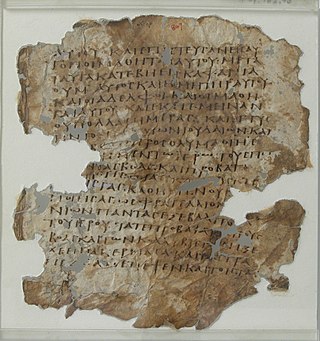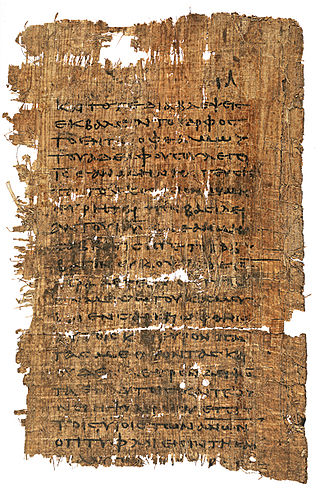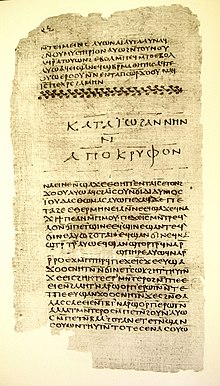
The Gospel of Thomas is an extra-canonical sayings gospel. It was discovered near Nag Hammadi, Egypt, in December 1945 among a group of books known as the Nag Hammadi library. Scholars speculate that the works were buried in response to a letter from Bishop Athanasius declaring a strict canon of Christian scripture. Scholars have proposed dates of composition as early as 60 AD and as late as 250 AD. Since its discovery, many scholars have seen it as evidence in support of the existence of a "Q source" which might have been very similar in its form as a collection of sayings of Jesus without any accounts of his deeds or his life and death, referred to as a sayings gospel.

The Nag Hammadi library is a collection of early Christian and Gnostic texts discovered near the Upper Egyptian town of Nag Hammadi in 1945.

The Gospel of Mary is a non-canonical text discovered in 1896 in a fifth-century papyrus codex written in Sahidic Coptic. This Berlin Codex was purchased in Cairo by German diplomat Carl Reinhardt.
The Berlin Codex, given the accession number Papyrus Berolinensis 8502, is a Coptic manuscript from the 5th century CE, unearthed in Akhmim, Egypt. In Cairo, in January 1896, Carl Reinhardt bought the codex, which had been recently discovered, wrapped in feathers, in a niche in a wall at a Christian burial site. It was a papyrus bound book, dating to early 5th century that was written in Sahidic dialect of Coptic, which was in common use in Egypt during that time.

The Gospel of the Truth is one of the Gnostic texts from the New Testament apocrypha found in the Nag Hammadi codices ("NHC"). It exists in two Coptic translations, a Subakhmimic rendition surviving almost in full in the first Nag Hammadi codex and a Sahidic in fragments in the twelfth codex.

There have been many Coptic versions of the Bible, including some of the earliest translations into any language. Several different versions were made in the ancient world, with different editions of the Old and New Testament in five of the dialects of Coptic: Bohairic (northern), Fayyumic, Sahidic (southern), Akhmimic and Mesokemic (middle). Biblical books were translated from the Alexandrian Greek version.

Uncial 0162, ε 023, is one vellum leaf of a Codex containing The Gospel of John in Greek. It has been paleographically assigned a 3rd or 4th century CE date.

The Oxyrhynchus Papyri are a group of manuscripts discovered during the late nineteenth and early twentieth centuries by papyrologists Bernard Pyne Grenfell and Arthur Surridge Hunt at an ancient rubbish dump near Oxyrhynchus in Egypt.

Papyrus 5, designated by siglum 𝔓5, is an early copy of the New Testament in Greek. It is a papyrus manuscript of the Gospel of John dating palaeographically to the early 3rd century. The papyrus is housed in the British Library. It has survived in a very fragmentary condition.
Codex Bodmer XIX is a Coptic uncial manuscript of the four Gospels, dated palaeographically to the 4th or 5th century. It contains the text of the Gospel of Matthew 14:28-28:20; Epistle to the Romans 1:1-2:3. It is written in the Sahidic dialect of the Coptic language.
Stephen Emmel is a Coptologist and musician.

Papyrus Oxyrhynchus 1 is a papyrus fragment of the logia of Jesus written in Greek. It was among the first of the Oxyrhynchus Papyri discovered by Grenfell and Hunt. It was discovered on the second day of excavation, 12 January 1897, in the garbage mounds in the Egyptian town of Oxyrhynchus. The fragment is dated to the early half of the 3rd century. Grenfell and Hunt originally dated the fragment between 150 and 300, but "probably not written much later than the year 200." It was later discovered to be the oldest manuscript of the Gospel of Thomas.
Papyrus Oxyrhynchus 654 is a papyrus fragment of the logia of Jesus written in Greek. It is one of the Oxyrhynchus Papyri discovered by Grenfell and Hunt between 1897 and 1904 in the Egyptian town of Oxyrhynchus. The fragment is dated to the middle or late of the 3rd century. It is one of only three Greek manuscripts of the Gospel of Thomas.

Papyrus Oxyrhynchus 655 is a papyrus fragment of the logia of Jesus written in Greek. It is one of the Oxyrhynchus Papyri discovered by Grenfell and Hunt between 1897 and 1904 in the Egyptian town of Oxyrhynchus. The fragment is dated to the early 3rd century. It is one of only three Greek manuscripts of the Gospel of Thomas.
British Library Or 4926 (1), known also as P. Lond. Copt. 522 (Crum), is a papyrus codex with a collection of early Christian Gnostic texts in Coptic. The manuscript has survived in a fragmentary condition. The codex is dated to the 4th century. Erroneously it is known also as British Library Or 4920 (1).
Nag Hammadi Codex XIII is a papyrus codex with a collection of early Christian Gnostic texts in Coptic. The manuscript is generally dated to the 4th century, though there is some debate regarding the original composition of the texts.

Papyrus 137 is an early fragment of the New Testament in Greek. The fragment is from a codex, written on both sides with text from the first chapter of the Gospel of Mark; verses 7–9 on the recto side and 16–18 on the verso side. The manuscript has been dated paleographically to the later 2nd or earlier 3rd century, and has been published in the Oxyrhynchus papyrus series as P.Oxy. LXXXIII 5345.
Wolf-Peter Funk was a German historian of religion and Coptologist known for his pioneering studies on Gnosticism, Manichaeism, and Coptic manuscripts such as the Nag Hammadi library.











